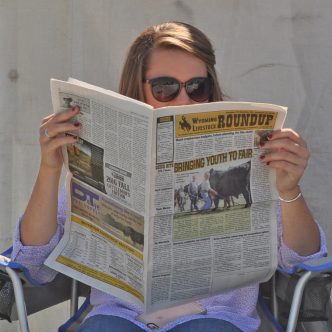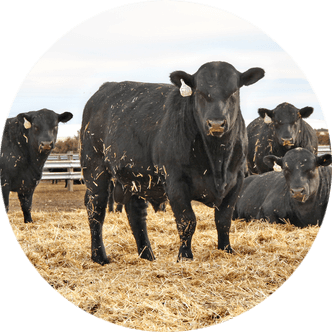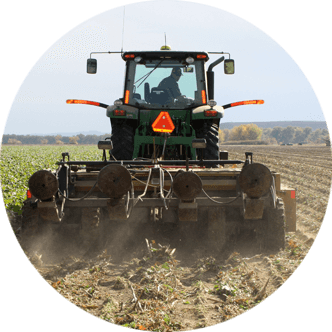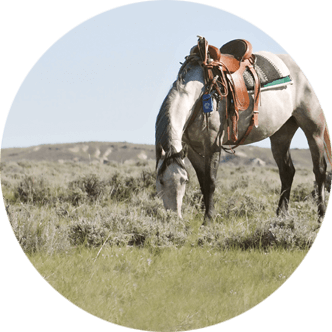SO Cattle Inc. and Frank Ranches: Multigenerational family ranch runs hardy Angus cattle in the Wind River foothills
At the base of the Wind River Mountain Range in Lander lies a multigenerational ranch run by the Frank and McConnell families.
The operation consists of a registered Black Angus herd by the name SO Cattle, Inc., as well as a commercial herd known as Frank Ranches.
Following
in family footsteps
Mark McConnell, fourth generation on the family ranch, shares, “My great-grandparents moved here in the 1940s from Kimball, Neb. They ran cattle, but they also liked to farm. While my grandpa and his brother were in high school and college, they raised bucking horses and rodeo stock as well.”
Mark notes his grandpa won the College National Finals Rodeo All-Around, competing in both bareback and saddle bronc riding.
“He also wrestled at the University of Wyoming, which I also got to do when I was in college,” he adds.
In addition to carrying on his grandfather’s college rodeo legacy, Mark is also following in his footsteps when it comes to fostering a passion for agriculture and keeping the family ranch in operation.
In fact, Mark recalls when he was little, his grandpa would take him along to spend two weeks in the mountains as a range rider.
“We’d keep track of the cattle and move them off of riparian areas. Then when I got older, I wasn’t able to get up there much,” Mark admits. “I suppose grandpa had a good plan – to show me while I was young what I could do when I got a little older and took charge.”
“When my grandpa and I would ride up there, we always talked about how someday I might get to do this with my own kids,” he continues. “It’s a lot of fun working with family, but it has its own challenges. In the end, however, I wouldn’t want it any other way.”
Raising Angus cattle
Mark shares, through the passage of time, the ranch has changed quite a bit from the early days.
Today, the Frank and McConnell families run all black-hided Angus cattle, including registered Angus seedstock and a commercial herd, utilizing both embryo transfer and artificial insemination technologies.
Cows calve in February, and pairs are turned out on a Bureau of Land Management allotment on June 1.
“Usually, we take them up a week early, where they stay on some private ground for some time before we turn them out,” Mark explains. “We use this same private ground to bring them down off the mountain when we wean calves in the fall. We can take the calves home and let the cows stay up there for another month or so until we bring them home in November.”
At 8,000 to 10,000 feet in elevation, the high-mountain pastures of the summer allotment makes for accurate pulmonary arterial pressure (PAP) testing. Mark notes all bulls are PAP tested and bred to be well rounded.
“Some people get focused on one trait, but it’s good to have a balance,” he states.
Additionally, the families retain their steers to sell as finished fat cattle. Although holding onto cattle this long may seem like a gamble, it allows the family to better understand the genetics they offer and how their cattle will perform.
Utilizing technology
As a younger rancher, Mark understands the importance of blending new and old technologies and techniques when it comes to running a successful operation.
Presently, the ranch utilizes a lot of relatively new technology like pivot irrigation, machinery, four-wheelers and motorbikes, but they still understand the importance of a good dog and a good horse.
“A bike or four-wheeler certainly has its place, but we don’t use them to move cows because we can’t get around in the mountains very well,” Mark explains. “We might use a bike to get out quickly and spot cattle so we don’t have to ride all day to find the cows we are looking for, but it always goes along with horses.”
“In the winter, I’ll use a four-wheeler to go out and tag new calves, but everything else is done with horses,” he adds. “We sort heavies with horses, and we do all of the cattle work with horses because it makes it fun and it’s also less stressful for the cattle.”
In addition to a good horse, dogs are also an essential part of the team.
“Growing up we had blue heeler dogs, but when I got out of college, I got a border collie and realized how much we’d been missing out,” says Mark. “I’ve had quite a few border collies now, and they are a lot of fun. A person can do a lot more by themselves with a good dog, especially in the brush and willows.”
Overcoming challenges
Like all of Wyoming’s gritty ranchers, the Frank and McConnell families have had their fair share of challenges, and running cattle in the big, wild country of the Wind River foothills is no exception.
While many in the area deal with relentless depredation by wolves and bears, Mark says their operation has been pretty fortunate.
“We’ve been fortunate to not have as many wolves on our place as some other folks. We get a few solitary wolves, but they are not as dangerous as a pack,” he shares. “We’ve had more grizzly problems than wolf kills, but it could be a lot worse. Over by Jackson or Dubois, you see a grizzly just about every time you step out of a vehicle. It’s been about five years since we’ve had a confirmed kill, so we’ve been pretty lucky.”
Mark explains the ranch’s location likely plays a role.
“We are pretty far down on the southern part of the Wind River Range. It’s kind of a weird spot, especially for the wolf issue,” he says. “We’ve seen a lot of them, but never more than one by itself.”
Predation is just one of many challenges that come with raising cattle in big country. Mark notes in Fremont County’s semi-arid environment, grass often matures short, requiring careful stocking rates, and because they run on wide, open pastures, they don’t have eyes on their cattle at all times.
“With such large amounts of land, I see my favorite cows in May when they go out to pasture, and I hope I see them again in November,” he states. “I might see them once or twice during the summer, but that would be pure coincidence.”
Cows run in these mountains have to take care of themselves, and it is survival of the fittest. They must make their own way and bring home a good calf.
“It’s a challenging way of life but it’s such a great one. There are a lot of happy times and a lot of tough, heartbreaking times,” Mark says. “But, it’s still a great way to live, work and raise a family.”
For more information on SO Cattle, Inc. and Frank Ranches, visit @SOCattleInc on Facebook.
Heather Smith Thomas is a corresponding writer for the Wyoming Livestock Roundup. Send comments on this article to roundup@wylr.net.





